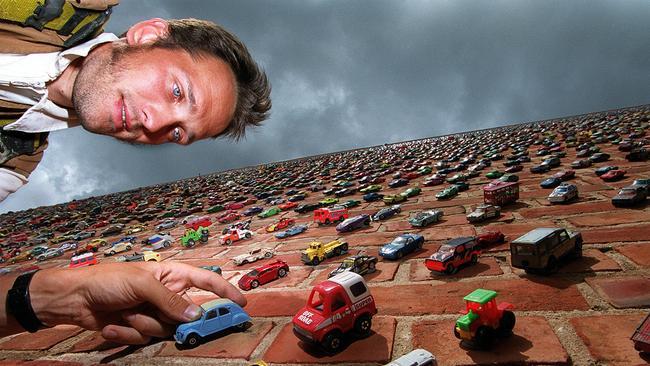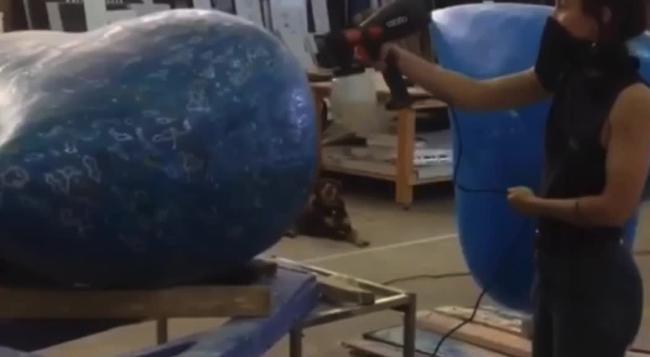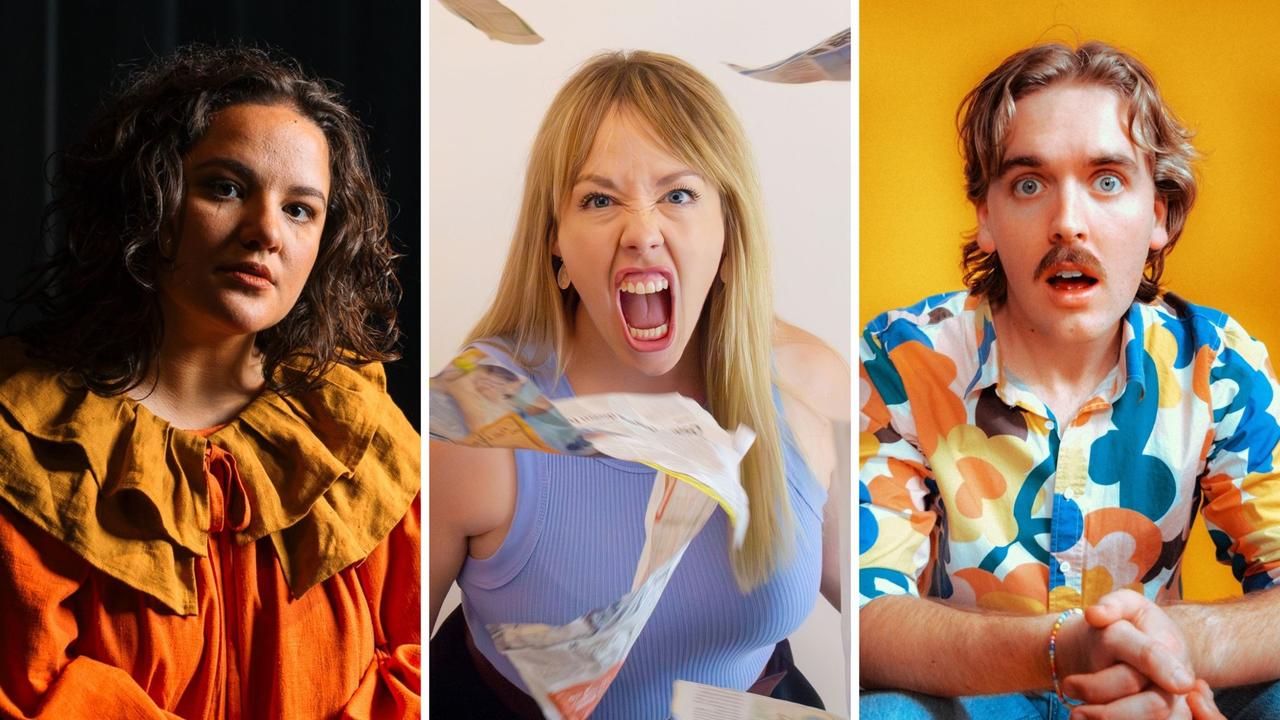Adelaide’s weird, wonderful and controversial public art
Melting forks, a chimp’s finger, a sculptural memorial to Elvis Presley — Adelaide has some weird and controversial public artworks. Here’s our top 10, and where you’ll find them.
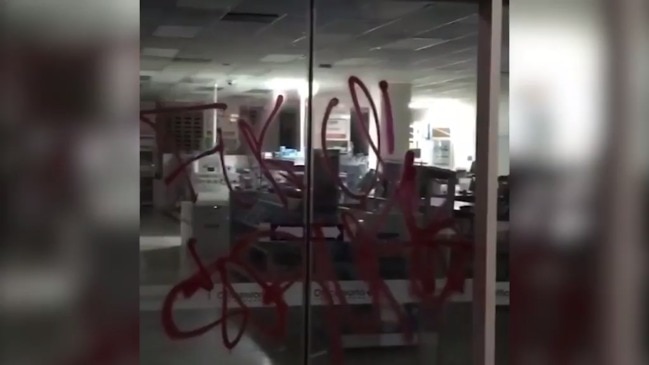
City
Don't miss out on the headlines from City. Followed categories will be added to My News.
Who would guess there is a sculptural memorial to Elvis Aaron Presley in a prominent place in Adelaide – have you seen it? The slightly bizarre garden shelter made of iron work dedicated to the King of Rock and Roll is top of our list of our weird and wonderful public art works of Adelaide.
1 Elvis Presley Memorial
Richard Howard (Botanic Garden)
Nothing says the ‘King of Rock and Roll’ like an elaborate garden shelter in iron work on a brick podium – right?
Well, that’s what South Australia’s Sound of Elvis Society believed.
Five years after the death of Elvis in August 1977, the society struck a deal with the Adelaide Botanic Gardens that its new sculptural display should be dedicated to the memory of the King.
Designed and constructed by SA blacksmith sculptor Richard Howard the memorial features gum leaves, gum nuts and South Australian birds.
Elvis once sang about birds in trees on the song I Want To Be Free, but there’s no suggestion this was the inspiration for the design.
Situated in a row of bay trees at the end of the walkway from the Botanic Garden gates on North Tce, the work was unveiled in 1982.
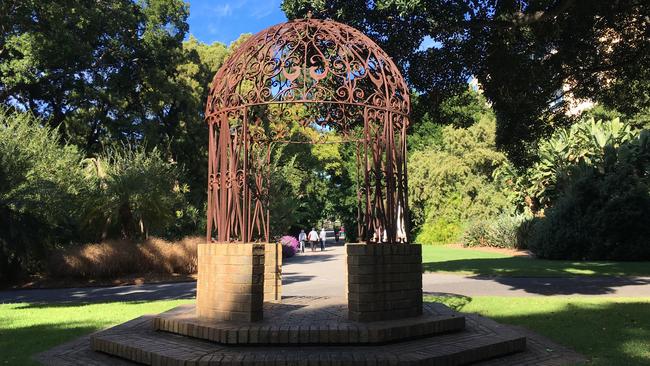
2 Untitled Steel Sculpture
Margel Hinder (Waymouth St)
It is untitled, hidden away and more than a little unloved but this steel structure (pictured) next to a carpark in Waymouth Street was created by one of Australia’s most prominent sculptors of the 20th century.
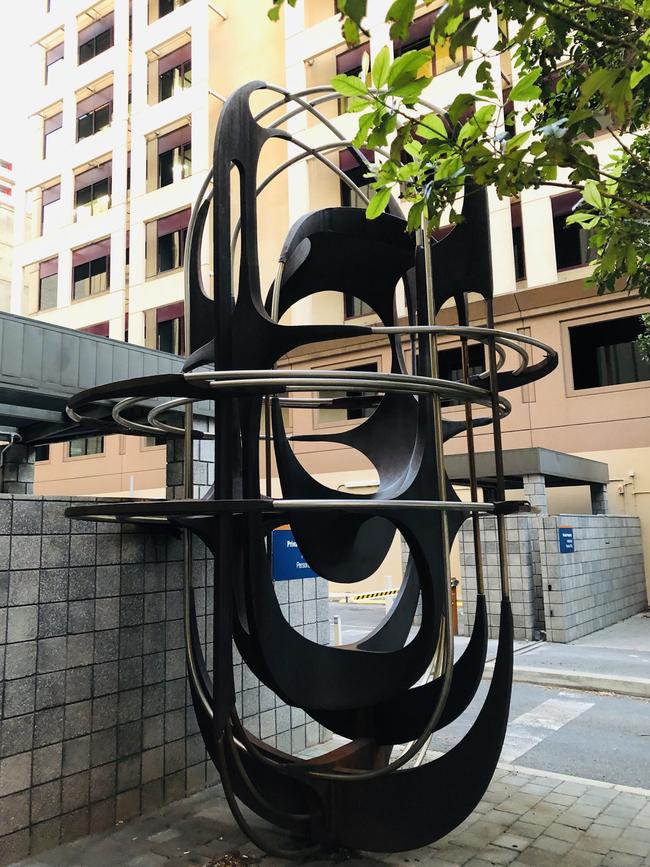
Margel Hinder was born in the US in 1906 and migrated to Sydney in 1934 after marrying Australian artist Frank Hinder.
Considered radical and experimental, she worked mostly in wood, before turning to metalwork when her creations became central to the new sculpture movement.
Hinder’s best known work includes one at the Australian Reserve Bank in Martin Place in Sydney, while her masterpiece is the Captain James Cook memorial water fountain in Newcastle.
It was created at the peak of her career and the same year, 1972, as the Waymouth Street work that is situated outside the Telstra exchange carpark.
Who commissioned the artwork and how much it cost is lost to the sands of time.
Hinder died in Sydney in 1995.
3 George and John Angas Memorial
William Colton (Torrens River)
George Fife Angas and his son, John Howard Angas, were wealthy pastoralists and powerful political figures in South Australia during the late 19th century.
Known as benefactors, it was no surprise when, on the death of John in 1904, a statue to stand in Victoria Square was proposed to the memory of father and son. The Angas family offered to pay for the lavish marble monument by the English sculptor William R. Colton.
The memorial features an intricate shelter supported by four columns with an Elizabethan ship on one of them. Keeping guard is a spectacular bronze angel.
When Adelaide City Council was informed it had promised the plot on the northwestern corner of Victoria Square to the Sturt Society to erect a statue of explorer Captain Charles Sturt, debate raged about where to place the Angas memorial.
Some critics decried the Angas legacy, suggesting they were less generous to the people of Adelaide than was initially believed.
The memorial, it was argued, had no place within the city limits. More than a decade after first being proposed, the memorial was completed in 1915 and situated in the Prince Henry Gardens on North Tce without an unveiling ceremony.
It was removed to its current position on the Torrens in 1929 during redevelopment of North Tce.
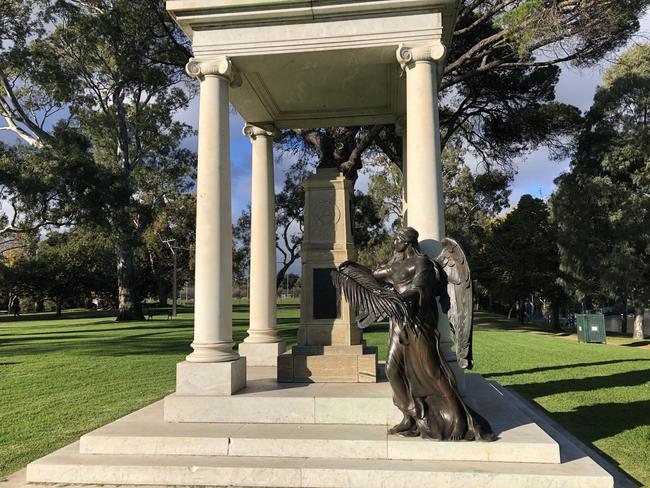
4 Venus di Canova
Pugi Brothers (North Tce)
No Adelaide statue has been more controversial than the naked form of Venus di Canova, carved emerging from her bath and attempting to cover herself.
Such was the outcry about a nude figure, albeit in Carrara marble, appearing at the corner of King William St and North Tce, that a letter to the editor of the Register newspaper railed vehemently about “the public exhibition of an indecent statue”.
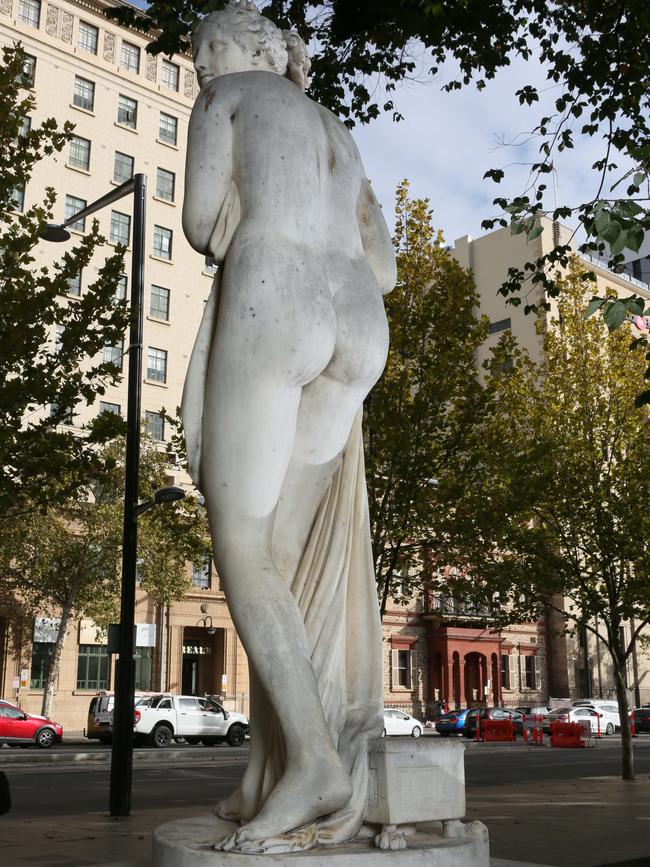
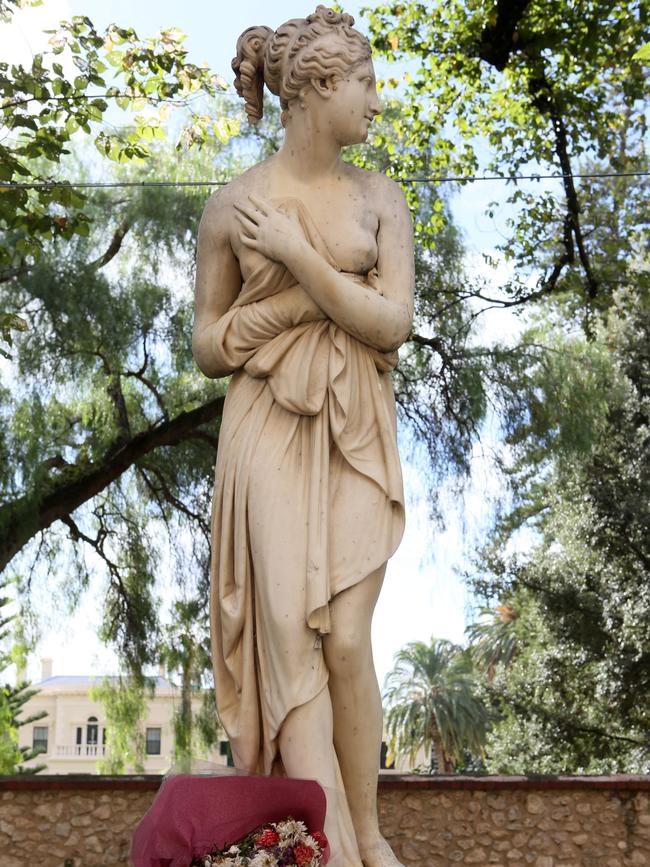
At the unveiling on September 3, 1892, Adelaide Mayor Fred Bullock remarked the statue had been deliberately placed close to the Government House guardhouse to deter “larrikinism and vandalism”.
The statue, a life-size copy of the Italian Venus (Venere Italica) by the Florentine sculptor Antonio Canova at the Pitti Palace in Florence, was carved by the Pugi brothers in Italy.
Wealthy pastoralist and philanthropist William Horn, who first found fortune with an investment in the Moonta Copper Mine, funded the work.
The statue was shifted to outside the South Australian Museum during an upgrading of the Prince Henry Gardens in 1930 and returned to its original position in 1960 to make way for the Bonython fountain that has since been removed.
Over the years there have been several attempts to damage the statue, including one on Victory in the Pacific Day on August 15, 1945 – after the surrender to the Allies by Japan – when it was doused in petrol and set alight.
5 J Reedman Memorial Drinking Fountain
Creswell Gardens
Statutes abound around Adelaide Oval to the state’s sporting heroes but none quite like the one to South Australia’s first great all-round champion.
Admirers of John Cole Reedman, the sporting superstar of his age who won 12 football premierships and an Australian Cricket Test Cap, determined a slightly odd-looking drinking fountain would be best to honour his memory.
Also known as Jack ‘Dinny’ Reedman, he was born in Tanunda in 1865 and moved to Adelaide for his schooling.
He played district football in 1885 with the Medindie club and then with South Adelaide, North Adelaide and West Adelaide.
A dashing all-rounder, he captained South Australia at cricket and played his only Test at Sydney in 1894-5, against England. A postman by trade, Reedman coached sport at St Peter’s College for several years and led an active life until his death aged 59.
The J Reedman Memorial Drinking Fountain, made of Angaston marble, was erected in Creswell Gardens outside the Adelaide Oval five years later – on September 7, 1929.
A former Adelaide Lord Mayor, Sir Wallace Bruce, announced:
“We remember Reedman as a fine colleague, a popular leader and a very fine gentleman. He did much to foster sport in South Australia and his example should be an inspiration to play the game.”
The fountain was restored in 2001 when a plaque was added.
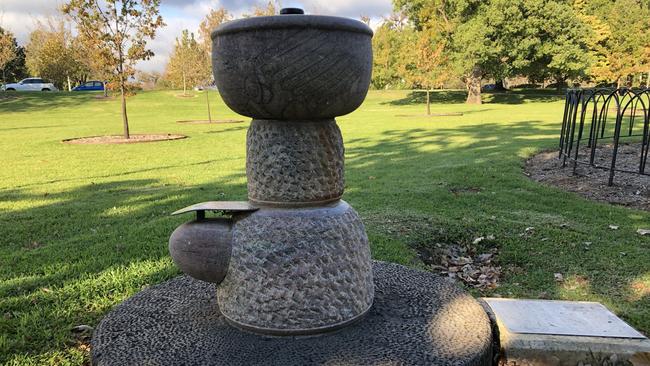
6 Lie Of The Land
Aleks Danko and Jude Walton (Sir Donald Bradman Drive)
Love them or hate them – and many do – these stone sculptures along the gateway to the City of Adelaide are a talking point for locals and visitors alike.
Funded by the then-Department for Transport, Urban Planning and the Arts in 2001, the work comprises 25 dome structures made from local bluestone using a drywall technique.
Set in compacted granitised sand, with native trees and kangaroo grass planted around they are transformed at night by an inventive lighting system.
The work, by Adelaide-born artist Aleks Danko and his partner and collaborator Jude Walton, was inspired by a Eugene von Guerard drawing in the South Australia Art Gallery. It details indigenous Australians camped in the Adelaide parklands at the time the city was settled.
The artists hoped their work, often dubbed the “wurleys” or “the beehives” would make people think about reconciliation and indigenous land rights but there were many early vocal critics who called them “badly designed kilns” and a waste of time and public money. The artwork took four years to construct and install, costing half a million dollars.
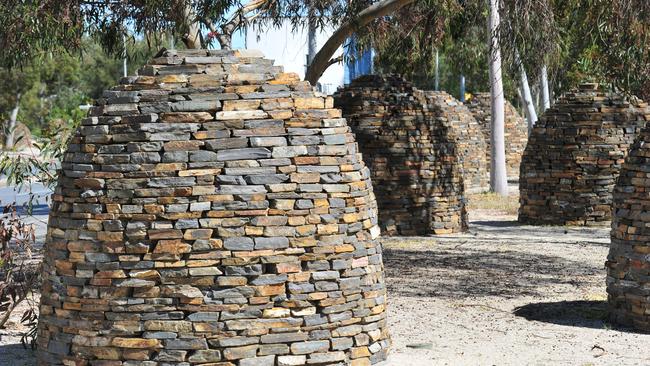
7 Chimpanzee Finger
Lisa Roet (Adelaide Zoo)
There would have been so many ideas and options for a sculpture to grace the new Adelaide Zoo entrance forecourt on Botanic Drive but few would have guessed a single digit would send people bananas.
Lisa Roet’s giant bronze Chimpanzee Finger was unveiled by British primatologist Dr Jane Goodall in 2011.
The acclaimed Melbourne artist’s interest in apes was sparked by one of Dr Goodall’s books. Dr Goodall had been her childhood heroine. Roet dreamt of studying primatology but had no aptitude for the requirement of physics.
“The index finger, especially, and the thumb are what defines us from other species of animal,” she said.
The Chimpanzee Finger, costing $60,000 and created in 2005, was donated to the zoo by benefactors Paul and Bronwyn Smith in memory of their children, Briana and Tom.
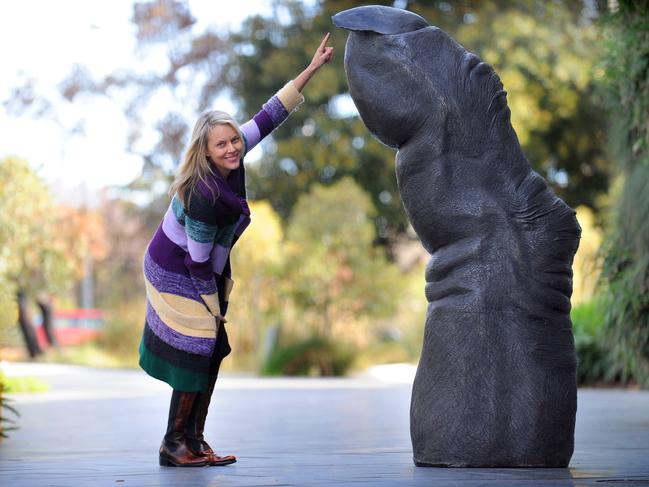
8 Fork! – Karl Meyer – Melbourne Street
Edwardstown-based artist Karl Meyer has a number of large sculptures around town, including the giant pair of intertwined hands recently revealed at the Centennial Park cemetery on Goodwood Road.
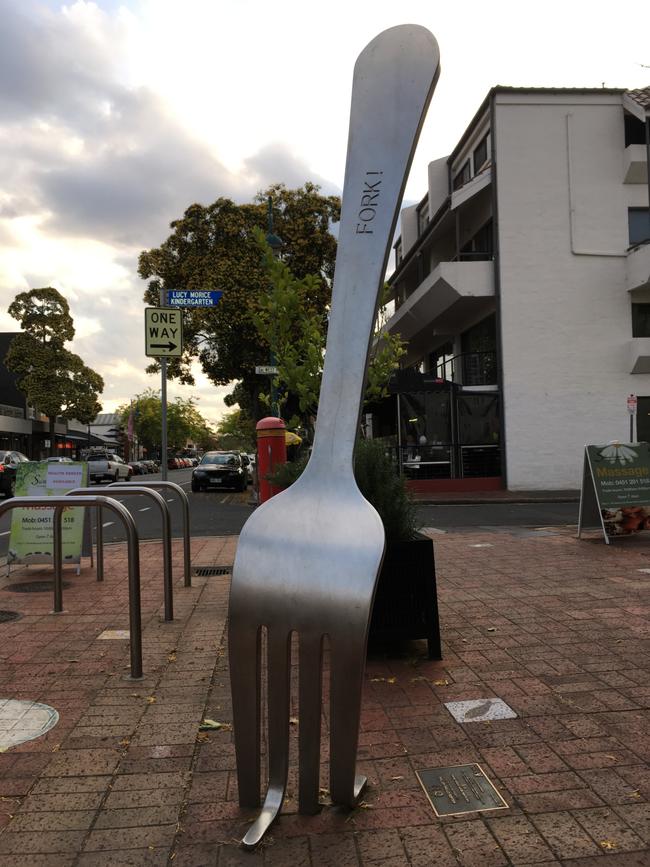
But few are as fun as Fork!, made in 2013, that celebrates the food culture and cafes of Melbourne St.
Constructed of durable stainless steel, laser cut and welded together, the two-and-a-half-metre sculpture took two months to complete.
Two of the fork’s prongs bend in opposite directions to express energy, poise and intrigue.
Among other Meyer sculptures to check out is the 20m-long ‘ticker tape’ message board on the outside of the building commissioned by the Royal Institution of Australia to celebrate its opening of the former Adelaide Stock Exchange, in Exchange Place, just off Pirie Street in the City.
9 Untitled
Donald Judd (Art Gallery of South Australia Garden)
American minimalist artist Donald Judd created this giant concrete triangle sitting out the back of the Art Gallery of South Australia but most visitors are unaware it’s a significant piece of art.
The work has been called the most contentious in the gallery’s long history. A grey discoloured mould of reinforced concrete can have that effect on some people.
Commissioned by the gallery at a cost of more than $8000, Judd arrived in Adelaide in May 1974 to begin plans.
When completed, in the dying days of the Vietnam War, some critics regarded the sculpture as a symbol of American imperialism.
Former gallery director Ron Radford was a fan, declaring the work one of the finest 20th-century sculptures in the collection but conceded, “Most people don’t even understand that it is a work of art at all.”
But the Art Gallery probably has a bargain on its hands for, since his death 25 years ago, Judd’s work sells for huge prices.
The artist’s auction record is held by another untitled large-scale sculpture – in galvanised iron, aluminium and wood, created in 1963 – that in 2013 sold for more than $14 million at Christie’s, New York.
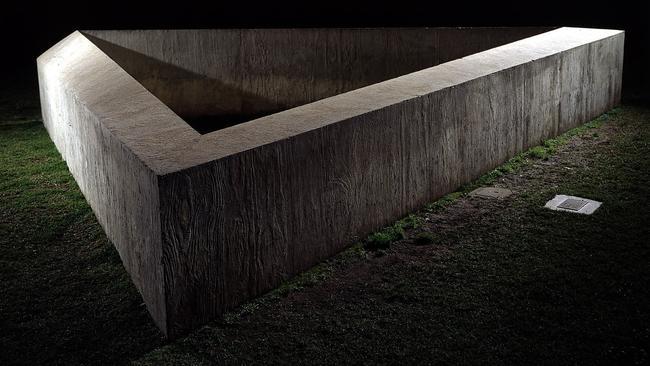
10 CARpark Members Only
Matej Andraz Vogricic (West End)
When Slovenian artist Matej Andraz Vogricic saw a huge, “beautiful” yellow brick wall in the centre of Adelaide with the words ‘small car’ and ‘members only’ painted in red on it – he knew immediately what he had to do.
What he did was create the world’s largest sculpture comprised entirely of matchbox cars.
Vogricic covered an entire brick wall adjoining the Rosina St carpark, between Hindley and Currie streets, with precisely 14,910 matchbox-size toy cars all donated by the generous people of South Australia.
He created a large carpark in the sky or, as he says, “an ever-present symbol of life in the inner city of Adelaide”.
“I was impressed by how important the car is in this city,’’ Vogricic said in 2000 at the completion of the project.
“I was impressed that you don’t have to try to hide carparks.
“In Europe we are always trying to hide them away, underneath buildings and so on.”
Commissioned for the 2000 Telstra Adelaide Festival as a temporary work, the sculpture has literally stuck around.
